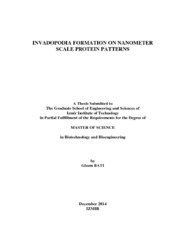Please use this identifier to cite or link to this item:
https://hdl.handle.net/11147/4305Full metadata record
| DC Field | Value | Language |
|---|---|---|
| dc.contributor.advisor | Pesen Okvur, Devrim | en_US |
| dc.contributor.advisor | Özyüzer, Lütfi | en_US |
| dc.contributor.author | Batı, Gizem | - |
| dc.date.accessioned | 2015-05-21T07:13:54Z | - |
| dc.date.available | 2015-05-21T07:13:54Z | - |
| dc.date.issued | 2014 | - |
| dc.identifier.citation | Batı, G. (2014). Invadopodia formation on nanometer scale protein patterns. Unpublished master's thesis, İzmir Institute of Technology, İzmir, Turkey | en_US |
| dc.identifier.uri | http://hdl.handle.net/11147/4305 | - |
| dc.description | Thesis (Master)--Izmir Institute of Technology, Biotechnology and Bioengineering, Izmir, 2014 | en_US |
| dc.description | Full text release delayed at author's request until 2018.01.26 | en_US |
| dc.description | Includes bibliographical references (leaves: 104-109) | en_US |
| dc.description | Text in English; Abstract: Turkish and English | en_US |
| dc.description | xvi, 109 leaves | en_US |
| dc.description.abstract | How the positions of invadopodium in the cell are determined and if they have an adhesivefunction are not known. Using fluorescence microscopy and antibodies that recognize actin, cortactin and MT1-MMP proteins, invadopodia formed by breast cancer cells plated on protein nanopatterns of different geometeries and components after stimulation with epidermal growth factor which is known to induce invadopodia formation, were examined. Invadopodia formation was studied for the first time on nanometer scale, single and double active component, protein patterns with equal distance and gradient spacings. The results show that: • On K-casein-fibronectin nanopatterns, invadopodia prefer to form on K-casein which blocks cell adhesion rather than on fibronectin nanodots which promote cell adhesion. • On Laminin-fibronectin nanopatterns, invadopodia prefer to form on laminin rather than on fibronectin nanodots. • On gradient patterns, invadopodia prefer areas with wide spacings. These results support the hypotheses that the positions where invadopodia form can be determined by surface protein nanopatterns and that cell adhesion is not required at points where invadopodia will form. | en_US |
| dc.language.iso | en | en_US |
| dc.publisher | Izmir Institute of Technology | en_US |
| dc.rights | info:eu-repo/semantics/openAccess | en_US |
| dc.subject | Biotechnology | en_US |
| dc.subject | Cancer cells | en_US |
| dc.subject.lcsh | Cell adhesion--Molecular aspects | en_US |
| dc.subject.lcsh | Breast--Cancer | en_US |
| dc.title | Invadopodia formation on nanometer scale protein patterns | en_US |
| dc.title.alternative | Nanometre ölçeğindeki protein desenleri üzerinde işgalci-ayak oluşumu | en_US |
| dc.type | Master Thesis | en_US |
| dc.institutionauthor | Batı, Gizem | - |
| dc.department | Thesis (Master)--İzmir Institute of Technology, Bioengineering | en_US |
| dc.relation.publicationcategory | Tez | en_US |
| item.languageiso639-1 | en | - |
| item.fulltext | With Fulltext | - |
| item.openairecristype | http://purl.org/coar/resource_type/c_18cf | - |
| item.openairetype | Master Thesis | - |
| item.grantfulltext | open | - |
| item.cerifentitytype | Publications | - |
| Appears in Collections: | Master Degree / Yüksek Lisans Tezleri | |
Files in This Item:
| File | Description | Size | Format | |
|---|---|---|---|---|
| T001327.pdf | MasterThesis | 3.39 MB | Adobe PDF |  View/Open |
CORE Recommender
Page view(s)
192
checked on Jul 22, 2024
Download(s)
72
checked on Jul 22, 2024
Google ScholarTM
Check
Items in GCRIS Repository are protected by copyright, with all rights reserved, unless otherwise indicated.